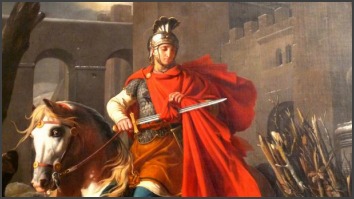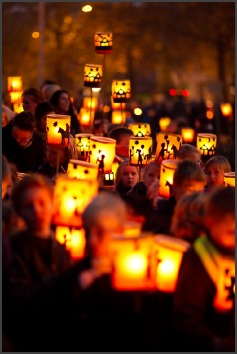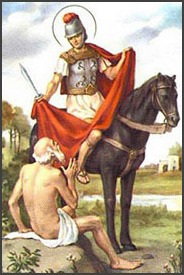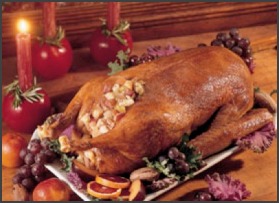 S
St. Martin’s Day (F
éill Mhartainn), also known
as the Feast of St. Martin or Martinmas, is a time for feasting and celebrations
usually held in November on the 11th day. In some countries celebrations would
begin at the eleventh minute of the eleventh hour of this eleventh day of the
eleventh month. Bonfires are built and children would carry lanterns after dark
singing songs for which they were rewarded with candy.
Martin was born around 316 of pagan parents. His father was a Roman Military
officer in Pavia, Italy. At the age of fifteen Martin joined the Roman Army and
was sent to Amiens. On a winter day while traveling on horseback in a snowstorm
he saw a poor beggar at the gate of the city of Amiens. Martin had no money to
give, but he divided his cloak in half and gave half to the poor beggar.
In a dream that night, Martin saw Jesus wearing the half-cloak. He had for some
time considered becoming a Christian, and this ended his wavering and he was
promptly baptized. At around 20 years of age Martin helped in repelling the
Teutons who invaded Gaul. After receiving his reward from Emperor Julian, he
asked to be released from the army, saying: “Hitherto I have faithfully served
Caesar. Let me now serve Christ.”
The Feast coincides not only with the end of the Octave of All Souls, but with
harvest time, the time when newly-produced wine and mead (beer) is ready for
drinking, and the end of winter preparations, including the butchering of
animals for meat and feasting.
It is said that one can predict what sort of Winter one will have by the
conditions of St. Martin’s Day: “If the geese at Martin’s Day stand on ice, they
will walk in mud at

Christmas.” The festival of St. Martin is the season when the new wines of the
year are drawn from the lees and tasted, when cattle are killed for winter food,
and fat geese are in their prime, and is held as a feast-day over most parts of
Christendom. An old English saying is “His Martinmas will come as it does to
every hog,” meaning “he will get his comeuppance” or “everyone must die”.
At Inverness, considered the capitol of the Highlands of Scotland, ancient fairs
and festivals were institutions pertaining to the Gaelic nations of Britain,
Ireland and Scotland. It is difficult even to guess how far back these ancient
festivals take us, but there would be little room to doubt that they had their
origin in pre-Christian times and were of great importance on a local and
national level.
The Martinmas festival was held in Inverness from ancient times and two local
poets who flourished during most of the nineteenth century thought this annual
event worthy of their muse.
“When Scotia’s hills with winter keen
Hae got their snawy suit on,
And bleak November hirples in
To gie puir folk their cloutin,
Bare sauls like me feel cauld, I ween,
When wintry storms are spouting;
Come, Muse, we'll seek some couthie ben,
And sing o'Clachnacuddin
On sic a day."
and another poet wrote:
"When cauld November's wind blaws chill,
And Sleety showers are fallin' --
When sonsy stacks the cornyards fill,
And fires warni ilka dwellin';
'Tis then the Fair, I mean to sing,
Is held in Nessia's Borough --,
Where Kintra wives their Kebbucks bring,
Laid out in order thorough,
An' gude this day."
 After
leaving the Roman army Martin met up with St. Hilary, Bishop of Poitiers and
became his disciple, living a solitary life until others gathered around him,
forming the Benedictine Abbey of Ligugé. After a decade of this life, he went on
journeys around the area to preach the Gospel, and his popularity grew to such
an extent that when St. Hilary of Poitier's successor died, the people of the
town elected St. Martin to succeed him as Bishop.
After
leaving the Roman army Martin met up with St. Hilary, Bishop of Poitiers and
became his disciple, living a solitary life until others gathered around him,
forming the Benedictine Abbey of Ligugé. After a decade of this life, he went on
journeys around the area to preach the Gospel, and his popularity grew to such
an extent that when St. Hilary of Poitier's successor died, the people of the
town elected St. Martin to succeed him as Bishop.
As Bishop, he led an exemplary simple life, a life that inspired the formation
of yet another monastery, one called Marmoutier. He fought battles against the
Priscillianists and Ithacians, evangelized and set up religious communities as
far away as Paris and Vienne, visited every parish in his large diocese each
year, and died around the age of 81, so loved that he became known as "The Glory
of Gaul." St. Martin is the patron of beggars, vintners, equestrians, soldiers,
tailors, innkeepers, alcoholics, and geese. He is usually depicted in art on
horseback, handing half of his cloak to a beggar, or relinquishing his arms. His
symbol is the goose. You may also see him riding on a donkey based on the
apocryphal story of him walking to Rome and meeting up with the devil, who
mocked him for not riding on a donkey as a Bishop should. St. Martin turned the
devil into a donkey and rode him all the way to Rome, urging him on with the
Sign of the Cross. The angered devil cursed him with this palindrome:
Signa te Signa: temere me tangis et angis:
Roma tibi subito motibus ibit amor
"Cross, cross thyself, you plague and vex me without need
For by my labors you shall soon reach Rome, the object of your wishes"

St. Martin's Day Goose
We shall conclude with a time weathered receipe for Goose with
Apple Stuffing, traditionally served on November 11th - St. Martin's Day.
Goose with Apple Stuffing
(Martinsgans mit Apfelfüllung) (Serves 6 to 8)
1 ready-to-cook goose (8 to 10 pounds)
2 cups water
1 small onion, sliced
1 1/4 teaspoon salt
6 cups soft bread crumbs
3 tart apples, chopped
2 stalks celery (with leaves), chopped
1 medium onion, chopped
1/4 cup margarine or butter, melted
2 teaspoons salt
1 teaspoon ground sage
1/2 teaspoon ground thyme
1/4 teaspoon pepper
1 teaspoon salt
1/4 cup all-purpose flour
Trim excess fat from goose. Heat giblets, water, sliced onion and 1 1/4
teaspoons salt to boiling; reduce heat. Cover and simmer until giblets are done,
about 1 hour. Strain broth; cover and refrigerate. Chop giblets; toss with
remaining ingredients except 1 teaspoon salt and the flour. Rub cavity of goose
with 1 teaspoon salt. Fold wings across back with tips touching. Fill neck and
body cavities of goose lightly with stuffing. Fasten neck skin of goose to back
with skewers. Fasten opening with skewers; lace with string. Tie drumsticks to
tail. Prick skin all over with fork. Place goose breast side up on rack in
shallow roasting pan. Roast uncovered in 350° oven until done, 3 to 3 1/2 hours,
removing excess fat from pan occasionally. Place a tent of aluminum foil loosely
over goose during last hour to prevent excessive browning. Goose is done when
drumstick meat feels very soft. Place goose on heated platter. Let stand 15
minutes for easier carving. Meanwhile, pour drippings from pan into bowl. Return
1/4 cup drippings to pan. Stir in flour. Cook over low heat, stirring
constantly, until smooth and bubbly. Remove from heat. If necessary, add enough
water to reserved broth to measure 2 cups. Stir into flour mixture. Heat to
boiling, stirring constantly. Boil and stir 1 minute. Serve goose with apple
stuffing and gravy.